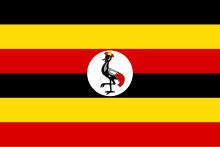 | |
| Data | |
|---|---|
| Water coverage (broad definition) | ("at least basic sanitation" / improved sanitation facilities) 92% / 79% (in 2015)[1] |
| Sanitation coverage (broad definition) | ("at least basic sanitation" / improved sanitation) 93% / 19% (in 2015)[2] |
| Continuity of supply | 20–24 hours per day in large towns[3]: page 58 |
| Average urban water use (L/person/day) | 44[4] |
| Average urban water and sanitation tariff (US$/m3) | 0.64[5] |
| Share of household metering | 99% in large towns (2006)[3]: page 23 |
| Annual investment in WSS | US$2.37 per capita[6][7][8] |
| Share of external financing | Mainly external donors |
| Institutions | |
| Decentralization to municipalities | Since 1997: To districts, towns and sub-counties[3]: page 8 |
| National water and sanitation company | National Water and Sewerage Corporation (NWSC), in large towns |
| Water and sanitation regulator | None |
| Responsibility for policy setting | Ministry of Water and Environment |
| Sector law | None |
| No. of urban service providers | n/a |
| No. of rural service providers | n/a |
The Ugandan water supply and sanitation sector made substantial progress in urban areas from the mid-1990s until at least 2006, with substantial increases in coverage as well as in operational and commercial performance.[9]: pages 3–4 Sector reforms from 1998 to 2003 included the commercialization and modernization of the National Water and Sewerage Corporation (NWSC) operating in cities and larger towns, as well as decentralization and private sector participation in small towns.[10]: page 15
These reforms have attracted significant international attention. Thirty-eight percent of the population, however, still had no access to an improved water source in 2010. Concerning access to improved sanitation, figures vary widely. According to government figures, it was 70 percent in rural areas and 81 percent in urban areas[11] while according to the United Nations (UN), access was only 34 percent.[12]
The water and sanitation sector was recognized as a key area under the 2004 Poverty Eradication Action Plan (PEAP), Uganda's main strategy paper to fight poverty.[13] A comprehensive expenditure framework was introduced to coordinate financial support by external donors, the national government, and non-governmental organizations.[3]: page 5 The PEAP estimated that from 2001 to 2015, about US$1.4 billion in total (US$92 million per year) was needed to increase water supply coverage up to 95 percent.[14]
- ^ WHO/UNICEF Joint Monitoring Programme. 2015. „Progress on Sanitation and Drinking Water: 2015 Update and MDG assessment: 75.
- ^ WHO/UNICEF Joint Monitoring Programme. 2015. „Progress on Sanitation and Drinking Water: 2015 Update and MDG assessment: 74.
- ^ a b c d Ministry of Water and Environment (Uganda) (September 2006). "Water and Sanitation Sector Performance Report 2006" (PDF). Archived from the original (PDF) on 18 March 2009. Retrieved 13 May 2008.
{{cite journal}}: Cite journal requires|journal=(help) - ^ National Water and Sewerage Corporation (2007). "Annual report 2006 to 2007" (PDF). Retrieved 8 May 2008.
{{cite journal}}: Cite journal requires|journal=(help) [dead link], p. 19; 23; 31 - ^ National Water and Sewerage Corporation (2007). "Annual report 2006 to 2007" (PDF). Retrieved 8 May 2008.
{{cite journal}}: Cite journal requires|journal=(help)[permanent dead link], p. 28 - ^ Ministry of Water and Environment (Uganda) (18 April 2008). "Sector Performance Report 2007. Executive Summary". Archived from the original on 24 July 2011. Retrieved 9 May 2008.
- ^ Uganda's population in 2007 was about 30.9 millionUnited States Department of State (April 2008). "Uganda (04/08)". Retrieved 9 May 2008.
- ^ USh 1/= = US$0.0005764 (31 December 2006); source: http://oanda.com
- ^ Mugisha, Silver; Berg, Sanford V. (September 2008). "State-Owned Enterprises: NWSC's Turnaround in Uganda". African Development Review. 20 (2). African Development Bank. Oxford, UK & Malden, MA: Blackwell Publishing Ltd (published 17 July 2008): 305–334. doi:10.1111/j.1467-8268.2008.00188.x. ISSN 1017-6772. SSRN 1088139. EBSCOhost 33208218.
Other versions of this:- Mugisha, Silver; Berg, Sanford V. (4 July 2006). 2. Turning around struggling state-owned enterprises in developing countries: The case of NWSC Uganda (PDF). Reforming public utilities to meet the water and sanitation Millennium Development Goal. UK’s Department for International Development: World Development Movement and WaterAid. pp. 11–32. Archived from the original on 4 July 2009.
- Mugisha, Silver; Berg, Sanford V. (March 2007). "2. Turning around struggling state-owned enterprises in developing countries: The case of NWSC-Uganda" (PDF). In Warwick, Hugh; Cann, Vicky (eds.). Going public: Southern solutions to the global water crisis (PDF). London, UK: World Development Movement. Archived from the original (PDF) on 16 November 2007.
- Mugisha, Silver; Berg, Sanford V. (24 April 2008). "State-Owned Enterprises: NWSC's Turnaround in Uganda". Retrieved 9 April 2024 – via ResearchGate.
- ^ Ministry of Water and Environment (2011). "Third Water and Environment Sector Performance Report". Archived from the original on 7 October 2011. Retrieved 16 July 2012.
- ^ World Health Organization; UNICEF. "Joint Monitoring Program". Archived from the original on 16 February 2008. Retrieved 16 July 2012.
- ^ Republic of Uganda; Ministry of Finance; Planning and Economic Development. "Poverty Eradication Action Plan (2004/5-2007/8)" (PDF). Archived from the original (PDF) on 10 October 2008. Retrieved 7 May 2008.
{{cite journal}}: Cite journal requires|journal=(help), pp. 182-188 - ^ Rural areas: US$956 million; Urban areas: large towns (US$281 million) and small towns (US$136 million).Republic of Uganda; Ministry of Finance; Planning and Economic Development. "Poverty Eradication Action Plan (2004/5-2007/8)" (PDF). Archived from the original (PDF) on 10 October 2008. Retrieved 7 May 2008.
{{cite journal}}: Cite journal requires|journal=(help), pp. 182-183
© MMXXIII Rich X Search. We shall prevail. All rights reserved. Rich X Search
